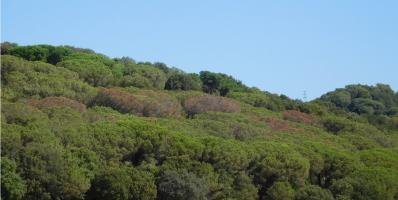DRASTIC
Tree water use and drought responses: the roles of allometry, water storage and transport under climate change
Increases in mean and extreme values of temperatures and vapour pressure deficits are increasing the risks of plant desiccation globally. Plants can either avoid or resist drought stress via the coordination of water transport and storage traits (i.e. hydraulic conductance and capacitance), to maintain safe levels of water status.
These traits have been typically measured in terminal branches or leaves but how they coordinate and scale at the whole plant level is not well understood. Because whole-plant traits can behave very differently from tissue-level traits, it is essential to advance our understanding of how whole-plant hydraulic properties vary both globally and at the local scale. In addition to this variability, tall trees vary dramatically in their properties along their vertical axis.
Terrestrial laser scanning TLS, allows accurate 3D reconstructions of tree architecture and can be used to upscale tissue-level traits to obtain whole-plant hydraulic properties. These properties can also be estimated from detailed physiological monitoring at the tree level, which provides a link with existing global datasets of tree and ecosystem water fluxes. This project will combine global databases with novel in situ datasets to test the following hypotheses: a) whole-tree hydraulic conductance and capacitance vary at the global scale as a function of climate, plant functional type and tree properties, b) in large mature trees of three Mediterranean species, water use responses to a severe experimental drought are determined less by vulnerability to embolism of their terminal branches than by the drought response of the entire tree, and c) bark and leaf capacitance control the early phases of water potential declines during drought, while xylem capacitance and residual evaporation losses control the later phases.
To achieve this, we will expand a global dataset of tree water use, SAPFLUXNET, that we created and are maintaining. We will estimate whole-tree capacitance and conductance by combining SAPFLUXNET with water potential data and we will compare these values with hydraulic traits of leaves and stems.. We will then establish a rainfall-exclusion field experiment on mature trees of three species, one pine and two oak species (one evergreen, one deciduous)in a Mediterranean forest. We will monitor tree water use, water content and water potentials over a 2-year period in leaves, branches and stems. Using TLS, we will determine the 3D architecture of our trees and will integrate tissue- and organ-level traits to quantify changes in whole-tree hydraulic capacitance and conductance as a function of species, treatment and season. A new analytical model will be parameterised for our trees to quantify the relative importance of allometric properties and tissue-specific traits in determining differences in whole-plant water use across species and in response to imposed drought.
The results of this proposal will contribute to improve our understanding of the patterns and mechanisms of tree drought responses at local to global scales, and will therefore appeal to the scientists in the areas of functional ecology and global change biology. Besides, the results and methodologies in this proposal will be of interest for forest managers and for the wider public interested in the effects of global change on Mediterranean forests.
Project PID2022-137270NB-I00 funded by MCIN/AEI /10.13039/501100011033/ and by FEDER A way of making Europe











